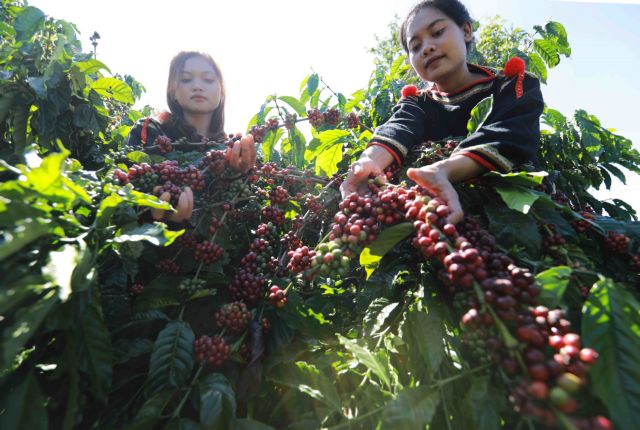 Society
Society


|
| Two ethnic women in Buôn Ma Thuột City, Đắk Lắk Province harvest coffee. — VNA/VNS Photo Vũ Sinh |
CENTRAL HIGHLANDS — The Central Highlands, home to nearly six million people, needs thorough solutions to issues related to land use, agro-forestry-fisheries development and ecological environment protection in order to deal with risks of instability in security and order.
Despite its great development potential, the region has still been struggling with many socio-economic difficulties and challenges, especially land-related problems.
Many local residents are short of farming land, while production land area is shrinking due to degradation of soil quality, inefficient land use, land dispute, encroachment, or speculation. This is one of the main causes of poverty, deforestation and risks of security and order instability in the region.
Recently, a terrorist attack at the administration caused serious insecurity and disorder in Đắk Lắk Province. Initial investigation results showed that hostile forces, supported by FULRO elements living in exile in the US, incited locals on cyberspace and divided people from the Kinh ethnic group and other ethnic minority groups under the cover of claiming land.
Settling land-related problems will not only solve the problem in local residents’ livelihood, but also tackle potential risk to security and order.
The region’s renovation and progress today is a result of the joint efforts of the Party, administration and local residents. Đắk Lắk has become the country’s coffee production hub, while Đà Lạt City in Lâm Đồng Province has become a famous tourism destination and the largest vegetable and flower hub of the country, and Gia Lai is a land of peppercorn and rubber.
The Central Highlands has 3.2 million hectares of forest land, accounting for 21 per cent of the country’s total, along with one million hectares of red basaltic soil area, 1.8 million hectares of Feralit red yellow soil area, as well as a diverse ecosystem and favourable weather conditions. It boasts great potential in energy industry development and rich natural resources, and is also home to many precious herbal plants such as Ngọc Linh ginseng, while owning plenty of advantages to become a major tourism centre of the country.
In order to boost the region’s growth, including agro-forestry development, it is crucial to deal with basic issues related to land. The situation of land disputes has seriously affected rural security, becoming a weakness for hostile forces to take advantage of for disruptive incitement.
Secretary of the Party Committee of Đắk Lắk Nguyễn Đình Trung pointed to the need for clearer mechanisms and policies for the management of land, especially forestry land in the Central Highlands. At the same time, it was necessary to clarify the management of forest and forest land as well as the switching of inefficient forest land into farming land, he said, stressing the need for mechanisms and policies to harmoniously settle the relations between forestry and agriculture in order to deal with land-related problems in the region.
Agriculture has played an important role in the development of the region, not only in the socio-economic aspects but also in terms of politics, security and defence. In other words, agriculture, farmers and rural areas are the foundation and strength for the region to improve locals’ living conditions and develop itself in a sustainable manner.
According to Trung, over the years, despite modest State budget collection, regional localities have designed various policies to support local people. They have paid great attention to renovating production methods by ethnic minority groups in the region, creating necessary conditions for them to access land and farming techniques and form cooperatives and cooperative groups to promote production, while encouraging local residents to change their mindset and inspire their desire to improve their material and spiritual living conditions.
Thanks to the issuance of the 9th-tenure Politburo’s Resolution 10-NQ/TW on promoting socio-economic development and ensuring security and defence in the Central Highlands, resources invested into the strategic region have increased, supporting its sustainable development.
The 13th-tenure Politburo has also issued a resolution to make a push for the region to develop green, circular and national cultural identity-imbued economy.
According to Chairman of the National Assembly’s Committee for Ethnic Minority Affairs Y Thanh Hà Niê KĐăm, stability and development of ethnic minority-inhabited areas is an important factor for the growth of the Central Highlands, and the foundation for the building of the great national solidarity bloc.
Therefore, it is necessary to design proper mechanisms and solutions to improve the living conditions of the local ethnic minority communities, while paying greater attention to the specificity, psychological characteristics, customs and habits of local residents when solving specific problems in the region. — VNS
Minister suggests further clarifying role, position of Central Highlands CENTRAL HIGHLANDS – The position, role and unique characteristics of the Central Highlands, including its culture and other related matters, should be further clarified, Minister of Planning and Investment Nguyễn Chí Dũng has said. Speaking at a recent press conference on a report on the framework orienting the planning of the Central Highlands for 2021-30 with a vision towards 2050, the minister stressed the need to carefully analyse the region’s difficulties and limitations including low growth and the lack of intra-region and inter-regional connectivity. More attention should be paid to water resources security, education, political security, social order and safety, as well as potential risks to national defence and security, Dũng noted. Meanwhile, the framework had yet to highlight the regional development space, bottlenecks to sub-regions, growth drivers and economic corridors, he said, asking localities to follow guidelines and relevant documents in planning. Mentioning the scenario on priority sectors, including tourism, the official urged reviewing land use, population density, economic activities and infrastructure to better the allocation of development space to sub-regions. Encompassing the five provinces of Kon Tum, Gia Lai, Đắk Lắk, Đắk Nông, and Lâm Đồng, the Central Highlands is blessed with favourable climate and soil conditions, and rich natural resources. It is connected with important seaports in the coastal central and southeastern regions and plays a crucial role in fresh water regulation and supply to localities in the two regions. The Central Highlands also boasts great potential for forest-based economic development, and agro-forestry product processing, mining, and especially tourism development with its diverse ethnic minority culture. The Politburo’s resolution on orientations for socio-economic development and national defence and security in the Central Highlands by 2030 with a vision towards 2045 targets rapid, sustainable development based on the green, circular economy for the region by 2030, turning it into an attractive destination for both domestic and foreign tourists. For the draft framework, economists pointed out limitations such as unreasonable population density, natural resources inefficiency, low workforce quality, and unattractive business environment. As the region plays an important role in the ecosystem and water resources security, some suggested planning conservation areas and development space, and maintaining environmental protection targets. —VNS |




